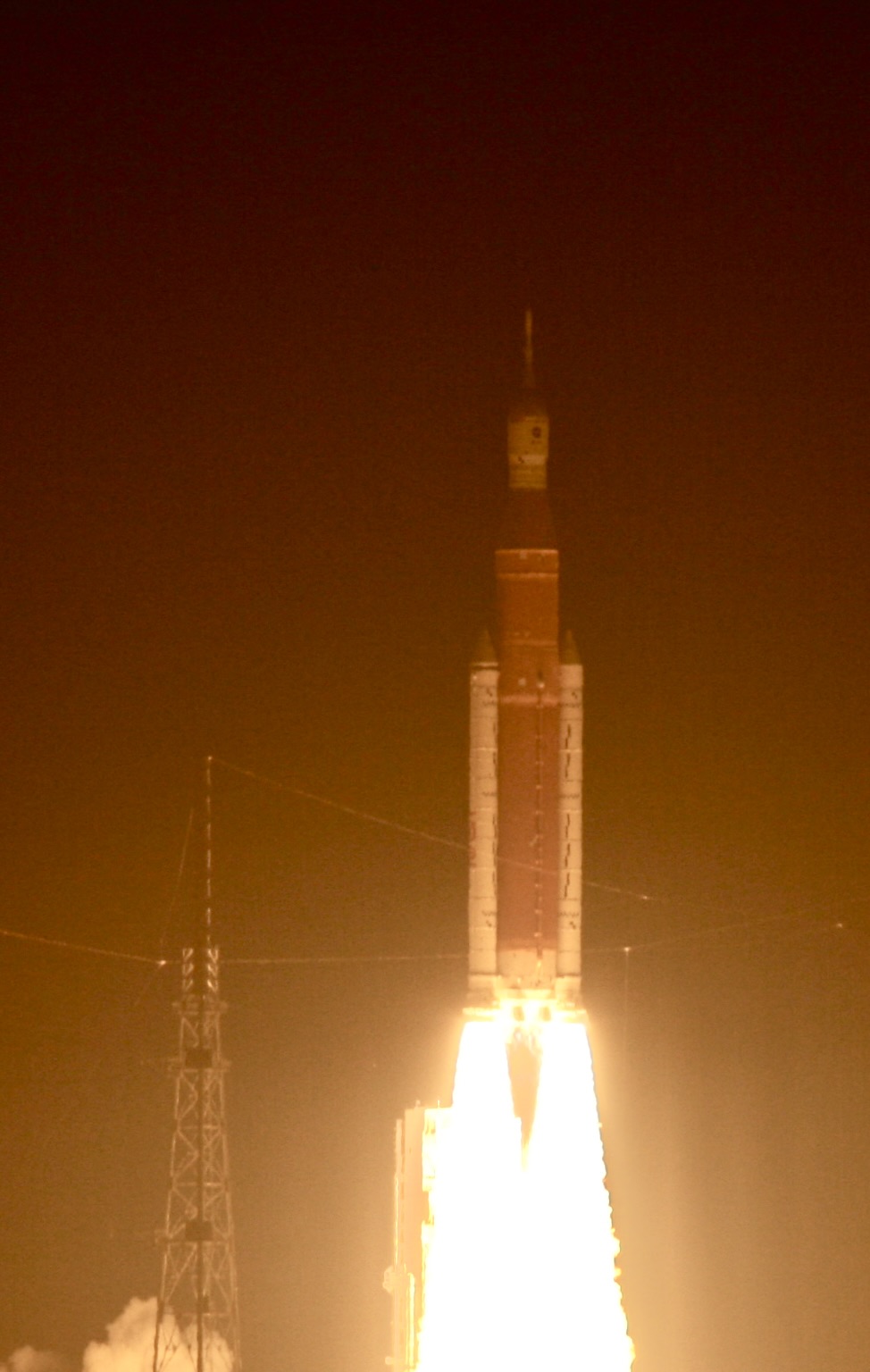(image credit: Christopher Mick)
By Christopher Mick
There are are over 75 reporters crammed into the “bullpen” at the NASA Media Center on the grounds of the Kennedy Space Center. This is the area where the press can plug in laptops, work on their stories and ask NASA Public Affairs Officers any technical questions they may have, and there are reporters here from all over the world. I overhear excited exchanges in German, Italian and Spanish as I walk to get a better view of one of the closed circuit monitors showing the Space Launch System (SLS) rocket on pad 39-B with clouds of venting liquid oxygen billowing away from the 322 foot tall rocket. It is November 16, 2022, the middle of the night, I am tired and am running on adrenaline, but there is no place that I would rather be. I have been issued press credentials from NASA to cover the Artemis 1 launch for my hometown newspaper. This will be the first launch of the fully integrated rocket, which consists of a core stage, two solid rocket boosters (SRB’s), a second stage with an Orion crew capsule coupled with a service module, and tipped by a solid fuel escape tower.
No crew will be on this first test flight of the SLS, but there will be a Snoopy as a zero-g indicator in the Orion capsule as well as a Shawn the Sheep contributed by the European Space Agency, who built the service module that provides the power and propulsion for the Orion. The Plan for Artemis 1 is a 26 day mission to travel out to the Moon and conduct what is called a distant retrograde orbit, which will swing the Orion capsule with its service module within 80 miles of the lunar surface and then 30, ooo miles farther away from the Moon where the the systems will be checked and tested before the Orion dives back towards the Moon for another 80 mile pass above the surface as it is flung back towards the Earth.
The Orion crew capsule will separate from the service module before reentering the earth’s atmosphere at 25,000 mph, the heat shield will face its final test, with the friction generating temperatures of 5,000 degrees Fahrenheit. Parachutes will then deploy to slow the capsule to a soft ocean splashdown off the coast of California.
And then just like that, all the years of assembly and testing were over. At 1:47 AM (EST) on November 16, 2022 the SLS leapt off the pad generating 8.8 million pounds of thrust, making it the most powerful rocket ever launched. The 25.5 day mission was a success, testing all of the SLS systems. NASA has recently named the crew for Artemis II, that will fly a 10-day mission in 2024 to become the first humans to have visited the Moon since Apollo 17 mission in 1972.
I wrote two articles for my local newspaper on covering the launch. A lot of interest from all grade levels has been expressed at the library and classroom programs I have held in my community. There are a lot of amazing activities that you can use to help explain the science involved, and the engineering challenges being faced to solve the problems of building new space suits, lunar rovers and landers. https://www.jpl.nasa.gov/edu/teach/activity/touchdown/ is a great group activity. Students can work individually or in pairs, and you can easily modify the provided supply lists to include things such as flexible straws for landing gears. I usually go for mini-marshmallows for my two crew members, but you can use anything lightweight, such as pompoms.
A slightly more advanced activity is https://www.jpl.nasa.gov/edu/teach/activity/foam-rocket/ This activity can really help participants understand terms such as thrust, stability, angle, down range, and apogee. This activity is well suited for an indoor gym or outside on a playground or grass area. I like to have participants aim for a target (I use hula hoops). 20 yard distance from the individuals launching the rockets is a good place to start.
And finally, http://clearinghouse.starnetlibraries.org/collections/DiscoverSpace/BuildASpaceColony-ActivityGuide.pdf This activity is one I usually try to plan out a few months from when I want to hold a Space Colony Build, so I have plenty of time to collect empty soda bottles, cereal boxes, coffee cans, egg cartons, or enlist your coworkers to help you with any leftover materials they might be able to bring in for you. I love this activity because it showcases the “A” in STEAM for art, and is very scaleable to the different age groups you may be working with. There can be more features and highly specialised areas to the Moon Colony for older participants, and a more streamlined simplified version for younger participants. Large sections of cardboard can be a great starting point that you can paint Moon gray that participants can use to construct their base on. Get creative, go big!!
I know after my time at the Kennedy Space Center interviewing astronauts, engineers and NASA officials about the Artemis Program (Artemis is the sister of Apollo in Greek mythology) that a whole new Artemis Generation will be inspired much like the Apollo Generation to explore, aim higher and maybe try something they had never considered before. With the Artemis III mission scheduled to land on the moon and elements of the Lunar Gateway space station being built and designs being considered for new lunar rovers to help transport astronauts on the surface of the Moon, the future for the Artemis Generation is looking bright.





Leave A Comment